|
|
|
|
|
|

SOUND SCULPTING EURORACK MODULAR
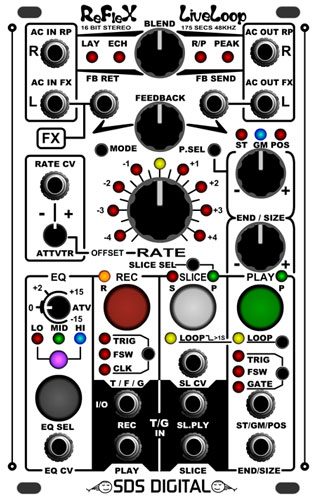
Introducing the Reflex LiveLoop! The tradition of sampling in the modular world has always been guitar pedal loopers, offering no external control, or a large complex external box, or modules with only 3 or 4 seconds of sample time. The Reflex LiveLoop breaks all of these barriers by gracing your rack with only 16HP, but sporting a full 174 seconds of sampling time @48KHz 16 bits, in stereo! This is better than CD quality sound, ready to manipulate with CV's and triggers in multiple layers, and record all at the same time.
The Reflex can slice up a long sample using the unique "peak slicing" algorithm, a trigger, or just a button. The power of these slices is then accessible via CV and trigger. Furthermore, they can be modified with the PlayFX button to tune the start and end points for each slice. These slices, or even samples, can also be Granulized into a micro loop, which then can move reverse or forward at varying rates up to 2 times. This also allows for pitch shifting a sample without changing the beat, or changing the speed without changing the pitch.
With 3 different Modes, Record/Play, Echo, and Layer, all with the ability to sync to an external clock, almost every sampler /looper requirement can be realised. Imagine an echo, synced by a trigger/ clock/ foot switch/ Record button, with controlled feedback and even a 3 band EQ. Then imagine it being 30 seconds or 8 bars long! The echo can be switched to an infinite echo that will continue forever, or can degrade according to feedback settings, EQ settings, or a feedback insert that can run through any filter or FX that you can imagine!
The Reflex LiveLoop can take you intuitively on a sonic voyage you don't want to miss!
The Reflex is packed with features making it a versatile and controllable sampler. Whether you want to create a layered and sync'ed loop and Sound-on-Sound into it at will, or modulate, sequence, and remix many samples into a collage of oblivion, the Reflex will get the job done. Here is the long list of features in sections:
| Record in stereo up to 174 seconds @48Ks/s, or slide down as low as 1.5Ks/s for a total Lo-Fi record time of 92 minutes. SOS Layering, Echo, R/P Modes. Record while playing slices, miniLoops, or G-Move grains playing in real time from -5 to + 5 Octaves. For more on recording, press the REC button! | |
| Create up to 400 Slices during record, play, playFX, G-Move or even slices! Audio Peak Slicing creates slices from sudden rises in audio levels, perfect for drums, piano, guitar, talking, or just about any type of "beaty" music. CV and trig controllable. For more on slices, press the SLICE button! | |
| Play a sample or slice as a Start/End, Position/Size, or G-Move granular Slide Play samples or slices in reverse at any Rate from 1.5Ks/s to 1500Ks/s (sim) Zero Latency audio with zero-crossing and soft mute technology. CV and trigger controllable. For more on PlayFX, press the PLAY button! | |
| Built in 3 band EQ with band select/ all for CV envelope of bands. Spectrum analyzer RGB LED to "see" the music and verifiy CV inputs. +/-5V control or 0-5V option. For more on EQ, press the PLAY button! |
| RECORD |
| The Record button has many functions, depending on
the mode. Intuitively, if there is no Playing or Recording of a sample, then
tapping the Record button always starts a Record. A second tap can switch to
Play the Sample, or set and Echo length, or set a Layer length, depending
again on the present Mode the Reflex LiveLoop is in. Double taps, and triple
taps are also acknowledged in in Layer (Sound-on-Sound) Mode. In all Modes, holding the Record Button will cause an All-Stop. Good for a panic button! During PlayFX mini-Looping: Record can be started during a PlayFX looping, G-Move play, or even PlayFX with a G-Move. Actions on PlayFX will be recorded for Slicing, playback, or starting a new PlayFX, as a normal record would, subject to the "rules" of the present Mode R/P, Echo, or Layer. During Play of Slices: Starting a record will modify the presently playing Slice if it was started by the Slice button. This can be a complete overwrite of the previous slice, or an overdub depending on the setting of the Feedback control. The record will continue looping inside of the slice, allowing infinite overdubs, until the Record button is tapped again, at which point the "new" slice will play. PlayFX of a live recording: If PlayFX (Play button or trigger) is started during a record, then the PlayFX will loop: The last echo, if in Echo Mode: Useful for reversing an Echo instantly! The last layer if in Layer Mode The entire sample from the last start of record, if in R/P Mode. Record will continue if required, but follows the rules of the Mode as to it's function. Record Rate is variable from "center" down. LED circle will indicate octaves down, which is useful for increasing record time (say by 24Ks/s would double it) while keeping some fidelity. |
| SLICE |
| The Slice Button is dual function: Slice Create,
(make slice) is the default state of the Slice button. If the Slice Select
button is pressed, then the Rate knob becomes a slice selector. The LED
Circle will indicate which slice is selected to play, as the Rate knob is
turned. Tapping on the Slice button will start any slice playing, selected
by the knob, or an incoming voltage on the Slice CV, which is added to the
Slice selected by the knob. This allows an entirely different set of slices
to be played if sequencing the CV input. Up to 400 slices can be created by
various methods all at once: Peak Slicing: Uses the audio on the AC output to recognize a valid audio Peak to slice. Manual Slicing: Manual taps on the Slice button will always create a slice (if SliceSel off) Trigger Slicing: The Slice Trigger input can create a slice. Useful for fine chopped slices! Record Slicer: A record action when in R/P sample Mode, or Layer Mode, will always create a new slice from a fresh start (i.e. no slices have been created since stopping) This is useful for recalling Layers, or sections of samples. Any slice created by the other 3 methods will erase these slices automatically. Slice Manipulation: Slices can be modified (i.e. start/end points, sample rate, direction) easily by invoking PlayFX during the playing and looping slice. If the Slice was started using the Slice button, then tapping PlayFX button will allow it to be modified. Tapping Record will save it. Slice Groove Sequence: A set of slices can be manually played/selected (or CV from a sequencer and/or trigger source, then played back instantly as a loop. Tapping in a groove is like a finger drum that remembers up to 200 taps and loops the beat non-stop, and can output a derived clock based on your rhythm! Slice Grooves can also be stepped by a clock or trigger, at any timing/variations. All you need to do is set the Slice order (up to 192 steps). |
| PLAYFX |
| The PlayFX button (Play for short) is the "window" of
opportunity for controlling and looping samples. As it is a separate entity
from normal Record/Play, it can be independent, yet not affect a recording
or play in progress. It takes over the sampler's output while the sample
continues to play silently, so it never falls out of sync. PlayFX has 3 main
modes that define the 2 knobs above it: Start/End: The knobs allow windowing of the sample (or slice) that was playing before the PlayFX button pressed. If the Start knob is Higher than the End, play reverses. Pos./Size: Position sets the beginning of the loop, and size determines the end. This can be very useful for panning back and forth through a sample. G-Move: G-Move, or Grain-Move, is different the the first 2 modes in that it uses time to set the loop point, rather that position in the sample. This allows for speeding up or slowing down the sample (via Rate) as pitch, without changing the progression through it. The top knob controls speed of this progression forward or reverse up to 2X. Slowing the G-Move time (size) can cause a stutter effect, while speeding it up creates odd harmonics and transients as the Pitch is shifted +/- 5 octaves. PlayFX can be freely recorded at any time, which allows "saving" of great sequences as a slice, to be recalled by a sequencer or manually using Slice select. On top of that, PlayFX can be started inside of a slice, so this recorded slice can be further modified for an ever evolving / changing soundscape. |
| EQ |
| The Reflex has a built-in +/- 15dB 3 Band Equalizer
to tailor sound on the output and change sound-on-sound attributes for Echo
and Layer modes. Because each band, and the Blend control, can be CV controlled (+/- 5V or 0-5V
option) individually or all together, a VCA of sorts can be emulated. By
holding the EQ Button, the CV input can be normalized for 0 - 5Volts. The default upon power-up is +/- 5V to match the EQ's +/- 15dB as 3dB/Volt. Of course, this CV input can envelope the audio output of the Reflex without having to use one of your precious VCA's! Using the EQ during echo/delay or any Sound on Sound mode can enhance feedback in each band area greatly which can create some dirty audio in a very short time! The Spectrum of the bands as adjusted is shown, as well as the audio output at all times, via an RGB LED. The default power-up Midrange frequency area is adjustable in user settings. |
| Multiple Modes |
| Besides the 3 Modes, RP/ Echo, & Layer and the PlayFX
Modes, Start/End, Position/Size, and G-Move, there are "hidden" modes. Phonogene Mode: Uses the Blend control to add faded-in overdubs of a running loop already recorded DJ Mode: Effectively a 4th PlayFX that makes the Reflex act as a turn table complete with variable speed/acceleration and reverse Stutter Modes: Instantly adds a controllable stutter to any loop, Slice, or PlayFX running. +Fine control for digital phasing FX Freeze Mode: Freeze any incoming audio according to PlayFX Start/End parameters/CV's PlayFX "Punch-in": Full Blend left will insert PlayFX in place of audio pass-thru (great with Freeze Mode) Karplus Mode: Not really a mode but a really fast echo. PlayFX and Slice modes change to take the recorded length into consideration. |
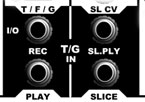 |
Triggers for Record steps, PlayFX trigger/re-trigger, slice Make & Slice Play Footswitch(S-Trig) inputs for Record and PlayFX, and Gate for PlayFX. Clock input for syncing Record functions. Clock /1 to /16 setting. Record T/F/C also outputs loop end triggers for external device syncing, as well as a derived Clock output during SGS (Slice Groove Sequencer) mode to sync other modules to your hand-tapped rhythmic Slice Sequence! |
  |
CV input through Attenuvertor for Sample Rate +/- 5 octaves @ 1V/Octave. CV in through dual mode Attenuvertor for +/- 15dB EQ bands (Selected or All) CV input 0-5V for externally controlled Slice Selection. CV inputs for PlayFX knobs offsets, and G-Move Direction/Speed/grain size. |
 |
PlayFX knob modes for Start-End, Position/Size, and G-Move
controls. PlayFX can play inside a Slice, sample, Layer, or Echo space.
PlayFX in Start/End mode can play samples in reverse. G-Move can move inside
a PlayFX, and will do "pseudo-reverse" effect, Ping Pong Stereo Grains, as
well as Live Pitch Shifting+delay These knobs also control Left & Right Channels for the new Stutter mode, and delay & size in the new Live Pitch Shifting mode. |
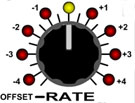 |
Rate can set the sample rate +/- 5 octaves and is a bipolar
offset to the CV in. Circle of LEDs around Rate knob indicate knob
"takeover" status when moving to modes set to different sample rates.
Also used for various functions such as Slice Select, Clock Divider select, Settings, and Session Load/Save with Flash-8 expansion. |
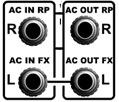 |
2 Channel Audio Input/Output. Left Channel input is normalized to the right, so a mono signal can drive both sides. output from a single input. 10V p-p. Minimal anti-alias filtering allows very high frequency signals to pass, so bending the nyquist limit can create some great FX/harmonics! |
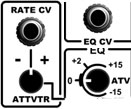 |
2 Attenuvertors, one for EQ band CV input, the other for Rate CV input "Attenuvertors" are CV Attenuators that can also invert the signal. CV Input Range of +/- 5 Volts. "Smart CV" on EQ input sets attenuvertor knob to +5V so still allows adjustment with no CV signal. EQ CV can be bipolar, or unipolar |
 |
Blend Incoming Audio with outgoing audio. Allows for smooth fade-in/outs Mutes at each end: Full right, input Audio is Muted, Full left, Sampler output is Muted. Independent of Feedback setting, a channel output can be used to loop back to feedback input, allowing for multi-level echo FX. CV Controllable |
 |
Feedback control of both sides RP(right) and FX(left) Can be used to set overdubbing or "punch in" levels Sets Echo Depth/Fade in conjunction with the EQ Band settings if not flat. Sets Level of FBK output to act as a 3rd channel for "Sample Only" output. |
|
|
3 Main Operating Modes, all Slice-able and PlayFX-able: R/P Mode: Simple Record/Play Samples and loop. Punch-in & Append ability. Echo Mode: Record-->Echo-->Infinite Echo Layer Mode: Record-->Record/Play-->Play-->Back Layers. SOS at it's finest! |
 |
Record /Play and PlayFX control via footswitches, perfect for hands-free use! S-Trigger (inverted trigger to ground) also allows for use with open collector. "Tap tempo" in only 2 taps from 1 beat to many bars. Better overall accuracy if performing live with a band, or just looping a guitar. Clock input to sync Echo/delay/Layer/Sequences |
| PlayFX and Slice Loops send a weak (5mA@5V)trigger on REC T/F/C at each Loop point to allow synchronization of other modules to the loop speed, or to patch back for slicing, triggering an ADSR for Rate or EQ control, or even syncing another Reflex. Clock Output during Slice Groove Sequencer mode! | |
| USB | Firmware upgrades, when posted in the Support section, can be easily uploaded to the Reflex via a USB interface on-board. Also an expansion port can allow future hardware upgrades to Modules by Sandy at SDS Digital. (Flash - 8 fall 2016) |
Demo Videos!
The video list for the Reflex Liveloop has gotten so large I have decided to
just link to youTube! Find videos on the Reflex, plus our other modules on the
Fresh Nelly youTube page.
Samples!
Here are some samples using the Reflex LiveLoop
SliceOverdubFun.mp3
Slice overdub is one of the more recent additions to the Reflex.
It's very simple, just hit record while playing Slices. New samples based on the
original slice lengths will be recorded. In this sample the PlayFX Start/End is
active with the knobs turned to play slices in reverse. The Blend is centered so
both incoming and sampled audio can be heard. With the feedback up. some of the
slice will also be recorded back into the new slices. If the slice happens to be
playing, then a wonderful effect occurs. This is what is at the start of the
sample.
KarplusKrazy.mp3
Here's what happens when setting a very tight echo, then changing the sample
Rate. Karplus craziness!
SDS_VCOtwo.mp3
Here's a pair of SDS_VCO's patched into each channel of the
Reflex. Live reversing of the VCO's with PlayFX produces a new texture to the
envelopes.
newFreezeMode.mp3
The new Freeze Mode demonstrated. Blend set fully left, recording, and hit
playFX in any mode to play what was just recorded back.
Slice Madness!
Vocal slices from the vocals chords of yours truly! PlayFX modes and Rate
changes etc. From old Flash webpages.
G-Move Sequenced Slices
This 2016 long sample has Grains, Karplus-like mods, and Indian music all rolled
up in one! Good to grab FX samples from.
Guitar Layers
This 2016 sample has Layers being made from Guitar and vocals
Reverse Karplus
This sample uses PlayFX Start-End in reverse to frame a Karplus recording (an
added feature after 2016 release) Amazing soundscape!
Bit-Depth Stutter Mode
Stutter mode can robotize just about anything into variable bit-sized grains
resulting in the ability to twist and re-record incoming audio! 2017.
Reflex + SDS_VCO + RIT_M Mayhem!
There's just so much going on in this 2018 sample I really can't comment on the
patch at all!
Reflex Slice Groove Sequence + RIT_M
Sample slices of EDM track vocals, Rate-scratching, and G-Move PlayFX, makes
this an interesting one!
| SPECS |
| Specifications: Audio Input P-P: 10V Audio Output Maximum: 12VP-P (input phased with output summed appx) Feedback Output: 10V P-P Audio Output Impedance: 220 ohm, Max Load (prolonged period) 200 ohms. Audio input Impedance: >100K, Feedback Return: >50K 10Vp-p Max before soft-distortion CV inputs Impedance: All >100K Trigger Inputs Impedance: 12K. REC Trigger Loop pulse output@1mS,5V@5mA = 1K Minimum Trigger Pulse: 10uS (tested) <2uS theoretical with good drive. Max ~150Hz cycle rate Maximum Slice Play: 10uS (tested) 100/second, max slice rate 100/second Maximum Trig in Volts: +/- 60 Volts. Rec T/F/C input: Max +60V, Max -10V (danger below -10V) Record Sample Rate: 1.5Ks/s to 48Ks/s @ 16 bits continuous Playback Sample Rate: 1.5Ks/s to 48Ks/s, 48Ks/s to 1536Ks/s (simulated) continuous Rate and EQ CV voltage range: -5V to +5V. Sample Rate/CV voltage: 1V/octave (.083V/note, 8 steps/note) 9.76 mV resolution Rate Knob offset +/- 5octaves Max Rate, EQ, CV Modulation Frequency:~ 200Hz reliably, 1KHz spooky particles. Max Slice CV response: 1mS reliably(Trigger offset wait time), better than 20KHz response Max Start/End CV response: >20KHz response, but depends on loops/mode/rate etc. Stock EQ Bands: 100Hz, 1KHz, 10Khz @ Q=1.0 (defaults) EQ Band Gain/Atten: +/- 15dB. Full Freq. response: 21Hz - 18KHz, extended Current Draw: @12V 190mA (LEDs Full); @-12V 56mA; @ 5V 0mA |
| Buy Me! | ||
| ** Note the Reflex Live Loop has been
discontinued, but the Flash-8 expansion is still
available
So you want to nab one before they're gone? Good decision!
The orders will be processed in the order they are received. If you have
any questions, don't hesitate to forward them to the above email address Update: Nov 25th 2016: The 3rd run of Reflex LiveLoops is in! The Flash-8 Expansions ($100) are also in and going out immediately. Nov 4th 2016: Development of the Flash-8 is complete, waiting for manufacture July 28th 2106: Postal strike is on hold so we have resumed shipping (well 1 week ago!) June 28th 2016: Postal strike is on, so no further orders can be shipped until mid-July (we guess) We will have the 2nd run of Reflex LiveLoops ready to go by May27 2017 Nov. 25th: 3rd Run of the Reflex now shipping! Also the Flash-8 Expansion is shipping. April 15th 2018: Out of stock (except Flash-8's) May 2nd 2018: Reflex's back in stock! Oct 12th 2021: Flash-8's back in stock! September 1st 2022: Flash-8's back in stock (but limited number due to chip shortages) Oct 29th 2022: Price change (slightly higher) due to parts prices increase March 27 2023: Due to higher chip prices and unavailability of some parts, sadly we had to discontinue the RLL. Firmware updates may still occur, so this page will remain! November 2023: Firmware Update V.3.03 to fix some annoying isues.
|
| SUPPORT |
|
Features List NEW! Breaking News! (Nov 13 2022) Reviews - Here you can find what others that already have a Reflex are saying (May 8th 2018)
Firmware UD
-This is where all of the firmware updates
are being posted. (May 8th 2018) Methods, Tips I've heard about -Any new features and their uses will be posted here. No matter the source, if we think it's cool, it'll be here! Flash-8 : This is the Flash-8 Expansion page In addition to the included "Quick-Quick Start" guide
sheet, we recommend the following guides: PDF Big Ugly User Manual for under your bed (not updated for V.2.00+ yet!) New! Ever-Growing RLL Patch Manual Flash-8 Reference Manual (.pdf) If You are getting a Flash-8, this is the manual to have * now with linked pages from index
Contact to Post a Reflex LiveLoop Review freshnel@freshnelly.com Contact fresh@freshnelly.com <<technical, or genah@freshnelly.com <<shipping/payment Firmware Updates newest V.3.03 (November 2023) DIY DJ MIDI Controller for
Record/Play Samples control! (2024)
|

Reflex LiveLoop (C) Fresh Nelly Musik 2024 . Last update January
2024